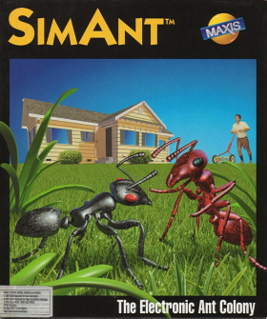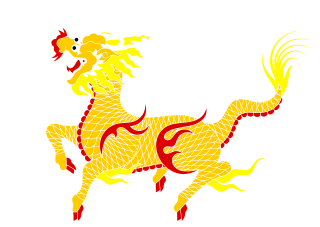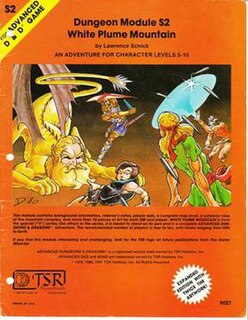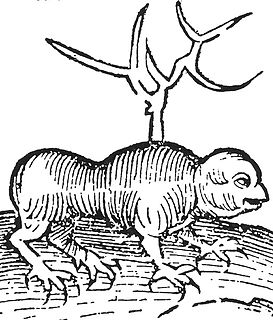
Dungeons & Dragons is a fantasy tabletop role-playing game (RPG) originally designed by Gary Gygax and Dave Arneson. It was first published in 1974 by Tactical Studies Rules, Inc. (TSR). It has been published by Wizards of the Coast since 1997. The game was derived from miniature wargames, with a variation of the 1971 game Chainmail serving as the initial rule system. D&D's publication is commonly recognized as the beginning of modern role-playing games and the role-playing game industry.

Dungeon was one of the two official magazines targeting consumers of the Dungeons & Dragons role-playing game and associated products; Dragon was the other.

SimAnt: The Electronic Ant Colony is a 1991 life simulation video game by Maxis and the company's third product, focusing on ants. It was designed by Will Wright. In 1992, it was named "Best Simulation Game" at the Software Publishers Association's Codie awards. SimAnt was re-released in 1993 as part of the SimClassics Volume 1 compilation alongside SimCity Classic and SimLife for PC, Mac and Amiga. In 1996 SimAnt alongside several of Maxis' simulation games were re-released under the Maxis Collector Series with greater compatibility with Windows 95 and differing box art, including the addition of Classics beneath the title.

The qilin is a legendary hooved chimerical creature that appears in Chinese mythology, and is said to appear with the imminent arrival or passing of a sage or illustrious ruler. Qilin are a specific type of the lin mythological family of one-horned beasts.

The magic in Dungeons & Dragons consists of the spells and magic systems used in the settings of the role-playing game Dungeons & Dragons (D&D). D&D defined the genre of fantasy role-playing games, and remains the most popular table-top version. Many of the original concepts have become widely used in the role-playing community across many different fictional worlds, as well as across all manner of popular media including books, board games, video games, and films.

The antlions are a group of about 2,000 species of insect in the family Myrmeleontidae, known for the fiercely predatory habits of their larvae, which in many species dig pits to trap passing ants or other prey. The adult insects are less well known, due to their relatively short lifespans compared to the larvae. Adults mostly fly at dusk or after dark, and may be mistakenly identified as dragonflies or damselflies; they are sometimes known as antlion lacewings. In North America, the larvae are sometimes referred to as doodlebugs because of the strange marks they leave in the sand.
Dungeons & Dragons is a fantasy role-playing game.

Euroleon nostras is a species of antlion found over most of Europe. The scientific name can be translated as "our European [ant] lion". Adults resemble dragonflies or damselflies and may reach up to 30 mm (1.2 in) long, with a wingspan of 70 mm (2.8 in). The larvae prey on ants and other small creatures and require dry sandy soil in which to dig their pitfall traps.
Andrea Di Vito is an Italian comic book artist.

White Plume Mountain is an adventure module for the Advanced Dungeons & Dragons fantasy role-playing game, written by Lawrence Schick and published by TSR in 1979. The 16-page adventure bears the code "S2". The adventure is a dungeon crawl where the players' characters are hired to retrieve three "notorious" magical weapons, each possessing its own intelligence. The adventure contains art by Erol Otus, and a cover by Jeff Dee. A sequel, Return to White Plume Mountain, was published in 1999, and an updated version conforming to v3.5 rules was released online in 2005. The original was again updated for the 5th edition in 2017 as the fourth part of Tales from the Yawning Portal.

Advanced Dungeons & Dragons: Treasure of Tarmin is a video game for the Intellivision video game console and the Mattel Aquarius computer system. This game was a licensed Dungeons & Dragons adaptation.

The Brachyceran family Vermileonidae is a small family of uncertain affinities and unusual biology. It includes fewer than 80 described species, most of them rare and with restricted distribution, in 10 genera. Historically the vermileonids had been regarded as belonging to the family Rhagionidae, possibly in a subfamily Vermileoninae. Their biology and morphology is so markedly distinct from the main Rhagionidae sensu stricto however, that the placement as a separate family has been widely accepted.
Chimera, originally found in Greek mythology, is a monstrous fire-breathing creature composed of the parts of multiple animals. The term, and often the general concept, has since been adopted by various works of popular culture, and chimeras of differing description can be found in contemporary works of fantasy and science fiction.
Blue Dragon may refer to:
Dungeons & Dragons (D&D) is a fantasy role-playing game first published in 1974. As the popularity of the game grew throughout the late-1970s and 1980s, it became referenced in popular culture more frequently. The complement of games, films and cultural references based on Dungeons & Dragons or similar fantasies, characters, and adventures became ubiquitous after the end of the 1970s.

The Myrmecoleon or Ant-lion is a fantastical animal from classical times, possibly derived from an error in the Septuagint version of the book of Job, reappearing in the Greek Christian Physiologus of the 3rd or 4th century A.D.

In Africa, the little five game animals are:

Weeleus acutus is an antlion of the Myrmeleontini tribe. It is endemic to New Zealand. This species was first described by Francis Walker in 1853.
Smaug is a dragon in J. R. R. Tolkien's novel The Hobbit.
This page is based on this
Wikipedia article Text is available under the
CC BY-SA 4.0 license; additional terms may apply.
Images, videos and audio are available under their respective licenses.












